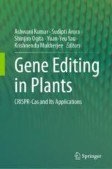Search
Search Results
-
Genome Engineering as a Tool for Enhancing Crop Traits: Lessons from CRISPR/Cas9
Over the last few decades, several efforts were made to improve cereal and horticulture crops, mainly using conventional or molecular breeding...
-
Precision mitochondrial DNA editing with high-fidelity DddA-derived base editors
Bacterial toxin DddA-derived cytosine base editors (DdCBEs)—composed of split DddA tox (a cytosine deaminase specific to double-stranded DNA),...

-
Targeted DNA Methylation in Mouse Early Embryos
In germ cell lines, including early preimplantation embryos, centromeres and pericentromeres are known to show a marked hypomethylation pattern...
-
Expanding Horizons: Role of Biotechnology in MAP Research, Production and Utilization
Plant tissue culture (PTC) plays a vital role in selection, multiplication, and conservation of the critical genotypes of medicinal plants. These...
-
Origin of the genome editing systems: application for crop improvement
In the last years, genome editing technologies led to a new era of genome engineering, enabling an effective, precise, and rapid engineering of the...

-
Targeted introduction of heritable point mutations into the plant mitochondrial genome
The development of technologies for the genetic manipulation of mitochondrial genomes remains a major challenge. Here we report a method for the...

-
Applications of Genome Editing Techniques for the Improvement of Medicinal Plants
Globally, medicinal plants play an indispensable role in curative as well as preventive medical therapy. The medicinal properties of plants are...
-
The Role of Transcription Factors in Response to Biotic Stresses in Potato (Solanum tuberosum L.)
Potato is an important horticultural crop worldwide, not only as a food but also as an emerging model plant. Understanding the gene pool regulation...
-
CRISPR/Cas Systems for Enhancing Photosynthesis: Climate Resilience and Food Production
To achieve the Sustainable Development Goal 2 (SDG 2) established by the UN, there is a need to produce 15–20% more food from recent trends of...
-
Designing Biomimicking Synthetic Transcription Factors for Therapeutic Gene Modulation
Inside living cells, natural transcription factors operate by precisely recognizing specific DNA sequences and by recruiting transcription ON/OFF...
-
Engineering Resistance to Bacterial Blight and Bacterial Leaf Streak in Rice
BackgroundXanthomonas oryzae ( Xo ) is one of the important pathogenic bacterial groups affecting rice production. Its pathovars Xanthomonas oryzae ...

-
Genome Editing and CRISPR-Cas Technology for Enhancing Abiotic Stress Tolerance in Cereals
Cereals comprise an indispensable part of the human diet. However, their production encounters various limitations, including reduced farming areas...
-
Editing of the rice importin gene IMPα1b results in sequestration of TAL effectors from plant cell nuclei
Transcription activator-like effectors (TALEs) produced by plant pathogenic bacteria mainly belonging to the genus Xanthomonas cause plant diseases...

-
Pearl Millet Blast Resistance: Current Status and Recent Advancements in Genomic Selection and Genome Editing Approaches
Pearl millet blast caused by Magnaporthe grisea is considered the most important disease of pearl millet worldwide since it is widespread and also...
-
Epigenetic rewriting at centromeric DNA repeats leads to increased chromatin accessibility and chromosomal instability
BackgroundCentromeric regions of human chromosomes contain large numbers of tandemly repeated α-satellite sequences. These sequences are covered with...

-
Modern Tools for Detection and Diagnosis of Plant Pathogens
Plant diseases contribute to an estimated annual crop loss of $60 billion worldwide, threatening the food security and thereby the survival of...
-
Biotechnology Strategies to Combat Plant Abiotic Stress
Adverse environmental conditions cause major challenge to crop production and have significant decreases in crop yields worldwide. Develo** stress...
-
The eINTACT system dissects bacterial exploitation of plant osmosignalling to enhance virulence
Bacteria inject effector proteins into host cells to manipulate cellular processes that promote disease. Since bacteria deliver minuscule amounts of...

-
Genome editing: An insight into disease resistance, production efficiency, and biomedical applications in livestock
AbstractOne of the primary concerns for the survival of the human species is the growing demand for food brought on by an increasing global...

-
Targeted knockout of a conserved plant mitochondrial gene by genome editing
Fusion proteins derived from transcription activator-like effectors (TALEs) have emerged as genome editing tools for mitochondria. TALE nucleases...

